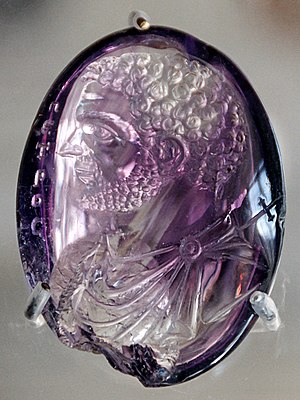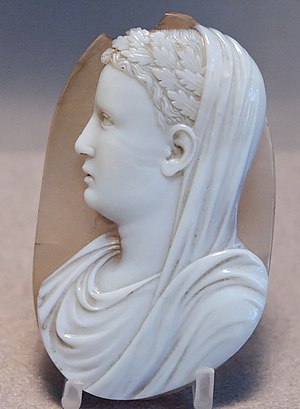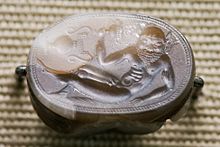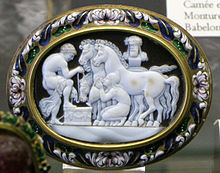Engraved gem


An engraved gem, frequently referred to as an intaglio, is a small and usually
Strictly speaking, engraving means carving in intaglio (with the design cut into the flat background of the stone), but
Glyptics or glyptic art covers the field of small carved stones, including
Technique
Gems were mostly cut by using abrasive powder from harder stones in conjunction with a hand-drill, probably often set in a
History

The technique has an ancient tradition in the
Round or oval Greek gems (along with similar objects in bone and ivory) are found from the 8th and 7th centuries BC, usually with animals in energetic geometric poses, often with a border marked by dots or a rim.[6] Early examples are mostly in softer stones. Gems of the 6th century are more often oval,[7] with a scarab back (in the past this type was called a "scarabaeus"), and human or divine figures as well as animals; the scarab form was apparently adopted from Phoenicia.[8] The forms are sophisticated for the period, despite the usually small size of the gems.[9] In the 5th century gems became somewhat larger, but still only 2-3 centimetres tall. Despite this, very fine detail is shown, including the eyelashes on one male head, perhaps a portrait. Four gems signed by Dexamenos of Chios are the finest of the period, two showing herons.[10]

Relief carving became common in 5th century BC Greece, and gradually most of the spectacular carved gems in the Western tradition were in relief, although the
The cameo, which is rare in intaglio form, seems to have reached Greece around the 3rd century; the
During the European
In the West production revived from the
Some gems in a remarkably effective evocation of classical style were made in
Renaissance revival

The late medieval French and Burgundian courts collected and commissioned gems, and began to use them for portraits. The British Museum has what is probably a seated portrait of John, Duke of Berry in intaglio on a sapphire, and the Hermitage has a cameo head of Charles VII of France.[19]
Interest had also revived in
By the 16th century carved and engraved gems were keenly collected across Europe for dedicated sections of a
Parallel traditions
Engraved gems occur in the
Many Asian and Middle Eastern cultures have their own traditions, although for example the important Chinese tradition of carved gemstones and hardstones, especially
Iconography

The iconography of gems is similar to that of coins, though more varied. Early gems mostly show animals. Gods, satyrs, and mythological scenes were common, and famous statues often represented – much modern knowledge of the poses of lost Greek cult statues such as Athena Promachos comes from the study of gems, which often have clearer images than coins.[27] A 6th(?) century BC Greek gem already shows Ajax committing suicide, with his name inscribed.[28] The story of Heracles was, as in other arts, the most common source of narrative subjects. A scene may be intended as the subject of an early Archaic gem, and certainly appears on 6th century examples from the later Archaic period.[29]
Portraits of monarchs are found from the Hellenistic period onwards, although as they do not usually have identifying inscriptions, many fine ones cannot be identified with a subject. In the Roman Imperial period, portraits of the imperial family were often produced for the court circle, and many of these have survived, especially a number of spectacular cameos from the time of
Renaissance and later gems remain dominated by the Hellenistic repertoire of subjects, though portraits in contemporary styles were also produced.
Collectors
Famous collectors begin with King
As in later periods objects carved in the round from semi-precious stone were regarded as a similar category of object; these are also known as
The collection of 827 engraved gems of
The
Three of the largest cameo gems from antiquity were created for members of the

In England, a false dawn of gem collecting was represented by
By the mid-eighteenth century prices had reached such a level that major collections could only be formed by the very wealthy; lesser collectors had to make do with collecting

In the eighteenth century British aristocrats were able to outcompete even the agents for royal and princely collectors on the Continent, aided by connoisseur-dealers like Count
The collection of
But the most famous English collection was that formed by the
Prince
Artists

As in other fields, not many ancient artists' names are known from literary sources, although some gems are signed. According to Pliny,
The
The Scot
Imitations

Cameo glass was invented by the Romans in about 30BC to imitate engraved hardstone cameos, with the advantage that consistent layering could be achieved even on round vessels – impossible with natural gemstones. It was however very difficult to manufacture and surviving pieces, mostly famously the Portland Vase, are actually much rarer than Roman gemstone cameos.[57] The technique was revived in the 18th and especially 19th centuries in England and elsewhere,[58] and was most effectively used in French Art Nouveau glass that made no attempt to follow classical styles.
The Middle Ages, which lived by
Another offshoot of the mania for engraved gems is the fine-grained slightly translucent stoneware called jasperware that was developed by Josiah Wedgwood and perfected in 1775.[60] Though white-on-blue matte jasperware is the most familiar Wedgwood ceramic line, still in production today and widely imitated since the mid-19th century, white-on-black was also produced. Wedgwood made notable jasperware copies of the Portland Vase and the Marlborough gem, a famous head of Antinous,[61] and interpreted in jasperware casts from antique gems by James Tassie. John Flaxman's neoclassical designs for jasperware were carried out in the extremely low relief typical of cameo production. Some other porcelain imitated three-layer cameos purely by paint, even in implausible objects like a flat Sèvres tea-tray of 1840.[62]
Scholars
Gems were a favourite topic for
Notes
- sard or carnelian, Etta M. Saunders, noted. Saunders, "Goddess Riding a Goat-Bull Monster: A Ceres Zodiac Gem from the Walters Art Gallery" The Journal of the Walters Art Gallery 49/50 (1991/1992;7–11) note 19
- O. M. Daltonobserved in "Mediæval and Later Engraved Gems in the British Museum — I" The Burlington Magazine for Connoisseurs 23 No. 123 (June 1913:128-136) and "II" The Burlington Magazine for Connoisseurs 24 No. 127 (October 1913:28–32).
- ^ Kornbluth, 8-16 quotes passages from Theophilius and others, and discusses various techniques. See Theophilius's article for full on-line texts.
- ^ Thoresen, "Gemstone enhancement"
- ^ "A brief history of engraved Classical gems". www.christies.com. Christie's. 28 May 2020. Archived from the original on 25 November 2021. Retrieved 9 January 2022.
- ^ Boardman, 39 See Beazley for more detail.
- ^ "Lenticular" or "lentoid" gems have the form of a lens.
- ^ Beazley, Later Archaic Greek gems: introduction.
- ^ Boardman, 68-69
- ^ Boardman, 129-130
- ^ Boardman, 187-188
- ^ Beazley, "Hellenistic gems: introduction"
- ^ Boardman, 275-6
- ^ Henderson, 112-113
- ^ De Natura fossilium Bk 1
- ^ Examples: 14th century French Crucifixion, Rosary pendant, 15th century, both onyx and in the MMA New York.
- ^ Kornbluth, 1, 4. Susanna Crystal, British Museum.
- ^ Kornbluth, 1, 4-6
- ^ Campbell, 411
- ^ a b c Draper, James David. "Cameo Appearances". In Heilbrunn Timeline of Art History. New York: The Metropolitan Museum of Art, 2000–. (August 2008)
- ISBN 978-0-8153-2935-0. p. 28/160 Google books. Image and description by Boardman Archived 2018-11-19 at the Wayback Machine
- ^ "Nowadays, however, they have been somewhat neglected—probably because a genuine gem is difficult to distinguish from forged one, and collectors have grown timid in consequence" (Richter, "Engraved Gems" The Metropolitan Museum of Art Bulletin, 17.9 (September 1922:193-196) p. 193
- ^ a b c Beazley, Boardman lecture Archived 2018-11-19 at the Wayback Machine
- ^ Getty, Collectors
- ^ Beazley Archive, "Late Antique, Early Christian and Jewish gems: Sasanian gems – Christian and Jewish"
- Numismatic evidence is the other most indicative evidence of the general pose of locally important cult images.
- ^ Beazley, Geometric and Early Archaic gems: Island gems 6th down.
- ^ Beazley, Archaic period pages
- ^ Hennig, 154-5. British Museum on the Blacas Cameo of Augustus.
- ^ Hennig, 153, Boardman, 275-6
- ^ Pliny, see below. Whether he was right to claim Mithridates as the first collector is dubious.
- ^ De Vita Caesarum, Divus Iulius, (The Lives of the Caesars, The Deified Julius), Fordham online text
- ^ Pliny, Natural History, xxxvii.5
- ^ "Treasury of San Marco". Archived from the original on 2016-03-09. Retrieved 2009-09-19.
- ^ Getty Collectors, under Pietro Barbó
- ^ It passed into the Arundel collection and came to Oxford: see Ashmolean image and description and Graham Pollard, "The Felix Gem at Oxford and its provenance" The Burlington Magazine 119 No. 893 (August 1977:574).
- ^ Online: The Introduction from Lorenzo de'Medici, Collector of Antiquities', by Laurie Fusco & Gino Corti, Cambridge UP 2006, which gives a survey of early Renaissance collecting in general. On his signing his gems see Draper
- ^ Gonzaga Cameo Archived 2012-02-23 at the Wayback Machine Exhibition in Mantua further details
- ^ "Mantua exhibition". Archived from the original on 2009-06-24. Retrieved 2009-09-15.
- ^ Roy Strong, Henry Prince of Wales and England's Lost Renaissance (1986:199).
- ^ Diana Scarisbrick, "The Devonshire Parure", Archaeologia 108 (1986:241).
- ^ "Sulphurs" provided even finer detail; James Tassie made a career of casting gems in plaster and in coloured opaque glass.
- ^ Apart from those mentioned below, there is information on other notable collections from the Getty Museum
- ^ "Hermitage Museum". Archived from the original on 2014-04-19. Retrieved 2009-09-14.
- ^ His correspondence with Henry Howard, 4th Earl of Carlisle is published by Diana Scarisbrick, "Gem Connoisseurship – The 4th Earl of Carlisle's Correspondence with Francesco de Ficoroni and Antonion Maria Zanetti", The Burlington Magazine 129No. 1007 (February 1987:90-104).
- ^ Towneley's were bought from his heirs, the others bequeathed. See King, 218-225 for a selection of highlights
- ^ Beazley, Marlborough Collection Archived 2015-07-29 at the Wayback Machine
- ^ a b Beazley, The Marlborough Gems, Boardman Lecture Archived 2018-11-19 at the Wayback Machine.
- ^ Walters, "Gems belonging to the Fourth Duke of Marlborough in the Walters"
- ^ John Beazley, The Poniatowski Collection of gems. More details in The Bernie Madoff of Gem Collectors
- ^ Boardman, 275-6. Hennig 153-4
- ^ Metropolitan
- ISBN 110459093X/ 1-104-59093-X)
- ^ Beazley, Tassie Archived 2019-03-25 at the Wayback Machine
- ^ Significant Figures in Art & Craft Today, Derek Reay, MoTi publishing, UK 2011
- ^ Trentinella, Rosemarie. "Roman Cameo Glass". In Heilbrunn Timeline of Art History. New York: The Metropolitan Museum of Art, 2000–9. link (October 2003, retr. 16 September, 2009); Whitehouse, David. Roman glass in the Corning Museum of Glass, Volume 1 Corning Museum of Glass. Google books
- ^ Texas A&M University Museum Archived 2009-04-08 at the Wayback Machine Exhibition feature George Woodall and the Art of English Cameo Glass
- ^ picture and link
- ^ Robin Reilly, Wedgwood Jasper London, 1972.
- ^ Antinoos.info See "Gems" section for gem and casts etc
- ^ Sèvres tea-tray from the Metropolitan museum of Art
References
- "Beazley" The Classical Art Research Centre, Oxford University. Beazley Archive Archived 2010-08-19 at the Wayback Machine – Extensive website on classical gems; page titles used as references
- ISBN 0-19-814386-9
- Campbell, Gordon (ed). The Grove Encyclopedia of Decorative Arts, Oxford University Press US, 2006,
- Furtwängler, Adolf. Die antiken Gemmen, 1900. This photo repertory was the cornerstone of modern studies.
- Henderson, George. Early Medieval Art, 1972, rev. 1977, Penguin.
- Henig, Martin (ed), A Handbook of Roman Art, Phaidon, 1983, ISBN 0-7148-2214-0
- King, C. W.; Handbook of Engraved Gems, 1866, reprinted Kessinger Publishing, 2003,
- Kornbluth, Genevra Alisoun. Engraved gems of the Carolingian empire, ISBN 0-271-01426-1. Google books
- Thoresen, Lisbet. "On Gemstones: Gemological and Analytical Studies of Ancient Intaglios and Cameos." In Ancient Glyptic Art- Gem Engraving and Gem Carving. LThoresen.com (February 2009)
- Gems and gem engraving by Pliny the Younger
Further reading
- Boardman, John. Island Gems, 1963.
- Boardman, John. Archaic Greek Gems, 1968.
- Brown, Clifford M. (ed). Engraved Gems : Survivals and Revivals, National Gallery of Art Washington, 1997. ISBN 978-0-89468-271-1
- Barrett, Caitlín E. "Plaster Perspectives on "Magical Gems": Rethinking the Meaning of "Magic" in Cornell's Dactyliotheca". Cornell Collection of Antiquities. Cornell University Library. Archived from the original on 26 May 2015. Retrieved 26 May 2015.
- Kunz, George Frederick (1911). . In Chisholm, Hugh (ed.). Encyclopædia Britannica. Vol. 16 (11th ed.). Cambridge University Press. pp. 195–199. This has more detail about lapidary in the ancient world, although only based on research available in the early 20th century.
External links
- Beazley Archive Archived 2010-08-19 at the Wayback Machine – Extensive site on classical gems
- Carvers and Collectors, a 2009 exhibition at the Getty Villa, with many features
- Digital Library Numis (DLN) Online books and articles on engraved gems
- The Johnston collection of engraved gems at the Metropolitan Museum of Art
- Damen, Giada. "Antique Engraved Gems and Renaissance Collectors", In Heilbrunn Timeline of Art History, New York: The Metropolitan Museum of Art, 2000–online (March 2013)
- Gems Collection: Cornell Collection of Antiquities, at Cornell University Library and Cornell: Gem Impressions Collection.
